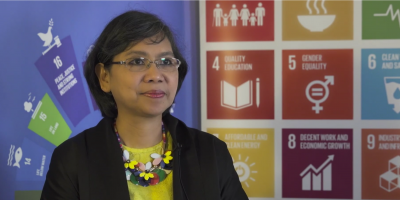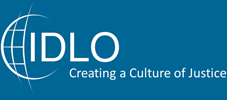
Lenny N. Rosalin is the Deputy Minister for Child Growth and Development within Indonesia’s Ministry of Women’s Empowerment and Child Protection. Since joining the Ministry in 2007, she has worked on various portfolios including violence against women, ‘child-friendly cities’ and protection of women laborers. She is now in charge of child growth and development.
IDLO spoke with Lenny N. Rosalin in the margins of the Global Conference on SDG 16 to discuss how the voices of children can be integrated in decision-making and how an inclusive, multi-stakeholder approach is the only way forward to realize justice, peace and sustainable development.
This interview has been edited for length and clarity.
How is Indonesia implementing SDG 16?
In the Government of Indonesia, we have already integrated SDG 16 and other SDGs into our national development plans, including our five-year national development plans but also our annual development plans. In this process, we have used a multi-stakeholder approach, involving the business community, non-governmental organizations, academics, women, children and even the media.
As a minister responsible for children’s development, I can describe how we involve children not only in the planning process but also in implementation. In this participatory process, we involve children, from the village to the national level. Thus, we are able to capture children’s voices and integrate them as input into our plans. This is directly in line with SDG 16’s requirements to improve participation and inclusion of women but also children and, of course, people with disabilities.
Is there another innovation you consider worthwhile sharing?
An innovation related to the SDGs that I would like to mention is the Child-Friendly Indonesia 2030 initiative. The ‘2030’ in the title is a reference to the 2030 Agenda and a timeline for us to contribute to making the world more child-friendly. In this initiative, we have identified and integrated five targets that are, according to us, of critical importance: children themselves as the principal actors; families; schools; factors to create an enabling environment; and regional targets.
For children, our first target, we have established so-called children’s forums.
For families, the second target, we have innovated by establishing family learning centers where we explain to families how to nurse children, how to prevent violence, and where they can access information for children and families.
For the third target, the schools, we are developing child-friendly schools in which we integrate the concepts of safe schools and healthy food, as well as safe routes to and from school. Our actions also aim to improve the knowledge of children and teachers in the field of climate change.
For the fourth target, the enabling environment, we have been working with religious and community leaders, as well as with children and women, but also with businesses. We have created the Indonesian Association of Child-Friendly Companies – a world first, which in 2013 received the United Nations Global Compact Award. We believe that the role of companies is to create a link between children’s rights and business principles through a human-based approach. So, we bring businesses into all the programs that contribute to the targets and indicators of the Child-Friendly Indonesia 2030 initiative, all of which are related to SDG 16. This is a highly integrated program.
For the fifth and final target, related to government, we work at the national and regional levels of administration. At the regional level, we have what we call the Innovation Integrated Child Mechanism, through which problems involving children can be reported and resolved locally. We also work at a grassroots level with local community leaders to help prevent, report and resolve children’s issues without having to go directly to the city, the provincial or even the national level. If a problem cannot be solved at the village or district level, then it can move up to the higher level. Children’s problems are thus solved at the most appropriate and efficient level of government.
With these five strategic pillars that we use and with SDG 16 indicators and assessments, we hope that our Child-Friendly Indonesia 2030 initiative can be achieved. We are committed to a truly multi-stakeholder and participatory approach.
What is your message for achieving SDG 16?
I think that the key to achieving SDG 16 around the world is to develop multi-stakeholder actions. All of us need to make sure that ‘no one is left behind’ is not just a catchphrase but that it is really integrated into policies and programs at the national and local levels.
The role of businesses, non-governmental organizations and academics is also very important, which is why we need to constantly seek their participation and involvement. We will only achieve SDG 16 if we work together.
My responsibility is linked to child development. One-third of Indonesia’s population (approximately 81 million people) is under 16 years of age. So, if we are able to inform this future generation at an early age and put them at the heart of the decision-making process, once they become adults, they will be able to implement the decisions they helped shape.

